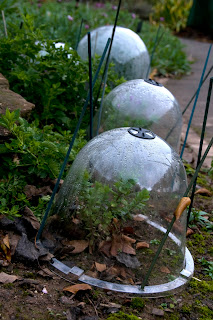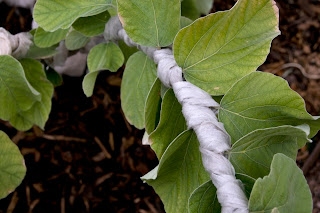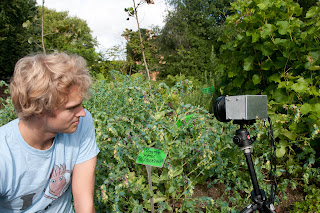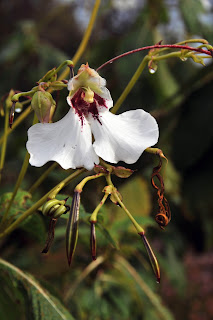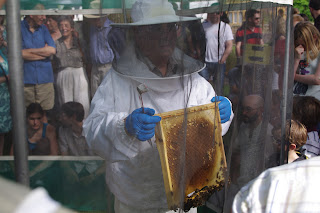This is my first day visiting the garden on a Tuesday. It’s a whole new set of faces around the coffee table as each day of the week brings with it a new set of volunteer gardeners at the Botanic Garden. I’ve brought some home-made cookies – a sort of bribe or peace offering I suppose. You see, I want to drag a few of these lovely volunteers away from their work for a few minutes to ask them about what motivates them to keep coming back to the garden, donating their precious time, week after week, year after year.
 |
Colin Bolton has been a volunteer gardener for nearly
ten years. |
After some discussion around the coffee table, Colin Bolton becomes my first volunteer interviewee. I’m not entirely sure he has actually volunteered himself…it rather seems that his fellow volunteers around the table have ‘volunteered’ him. He’s willing to go with the flow though.
Colin has been a volunteer gardener at the Botanic Garden for nearly ten years, coming in one morning a week. He is a chemist by training and is a retired lecturer from the University of Bristol’s
Faculty of Medicine. He heard about the opportunity to volunteer through his son
Mark Bolton, who is a well-known garden and flower photographer and has worked with a number of people in the Botanic Garden for various projects. Colin thought he would give volunteer gardening a go.
However, immediately before he was about to start, Colin was struck with meningitis and was very seriously ill in hospital for about six weeks.
“The medical staff were amazed that I came out of hospital, I was so ill,” Colin tells me. “I began volunteering for the garden right after that as a bit of therapy.”
For Colin, it seems to be the people in the Garden that he works with that have kept him coming back all these years.
“They are such nice people to work with and it’s lovely to work with people who know what they’re doing. They’re good teachers and everyone is very friendly, right from Nick [the curator] downwards.”
Colin began volunteering a couple of years before the Garden moved locations and he recalls the move well.
“The move was quite a performance…moving so many plants that were really well established. I can still remember seeing Andy digging around the roots of a really well established tree. He was digging down six feet and across just as much.”
When I ask him whether he was a big gardener before volunteering here, Colin tells me that he and his wife do have a fair size garden at home. He claims that his wife is really the creative genius in their own garden though. Then with a smile on his face, he describes his role as the unpaid labourer.
 |
Judith Moore (second from the left) started her own
gardening business after she became a
volunteer gardener. |
Next, I head off to find Judith Moore. She is sweeping leaves with a few of the other volunteer gardeners, Judy, Zaria and Marion, and I can hear the laughter and chatter long before I spot them.
Judith began volunteering as a gardener just after the garden had moved. She was a social worker and found herself between jobs and looking for something to do. Having visited the Garden at the old site quite a lot, Judith felt quite an attachment to it. She had always had an interest in gardening, so she began volunteering one morning a week. That was over seven years ago.
Volunteering in the Garden inspired Judith to start her own business and become a self-employed gardener, which she’s been doing now for about six years.
“I’d never thought about doing paid work as a gardener, but being here made me think about it. It just made me think, ‘well yeah, I could do this’. So I did.”
Judith completed horticulture training courses through the
Royal Horticultural Society at the Botanic Garden and spoke to me about many of the other benefits she receives being a volunteer gardener: “It’s a fantastic network here. [The Botanic Garden] is a source of lots of things – information and ideas, but also work.”
People often phone the Botanic Garden inquiring about gardeners and they refer them to Judith. She’s acquired two of her clients this way. But, it’s more than this that has kept Judith coming back over the years.
“I’m sure everyone will say this to you, but the paid gardeners here are such nice people. Day to day it is just such a pleasant environment to be in, but also you feel that they’re all very supportive of us.”
When I point out that Judith’s volunteering commitment means hours that she can’t put toward building her business and her paid work, she simply replies, “I think that highlights how good it is coming here, because I really didn’t want to stop this connection. It sort of feeds you.”
I couldn’t have said it better myself.
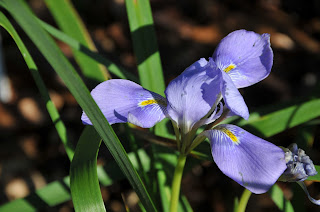 |
| Iris unguicularis in bloom in the garden on January 15th. |
Before I leave, I take a whirl around the garden to see what’s going on. There are some irises in bloom, which offer a beautiful splash of colour against the winter back drop and I stop to take a photograph. I run into Martin Webb who is working hard. Martin and his wife Carole started volunteering with the Botanic Garden about seven years ago, when it moved to its current location. Like many of the volunteers, Martin and Carole span the different groups of volunteers and are volunteer gardeners, volunteer guides and are also very involved with
The Friends.
“ We’ve seen the garden grow up in this location,” says Martin, “which means that from a gardening point of view you feel as though you own a little bit of it because you can say, ‘I did that’ or ‘I helped with this’. It also helps with the guiding because when people ask questions you can tell them an anecdote because you know where things have come from and how things used to look before.”
Martin immediately slips into his role as a guide without knowing it and points to an area beyond where we’re standing and starts drawing upon his anecdotes: “When we first came, all of this wasn’t planted and you had to take your cue from Nick, who painted a picture of what things were going to look like and then we had to try and see what he was seeing.”
Martin enjoys being on the interface between the garden and those who come to take pleasure in it. He and Carole both give tours for both adults and children and he spends some time telling me about how touring children about the garden requires completely different techniques.
“You get them to pick up a few leaves and have a look at them – some are glossy, some are prickly, some are waxy, some are furry – and you get them to have a feel. We talk about why the leaves are different and we basically have a mini botany lesson.”
 |
Martin Webb is both a volunteer gardener
and a volunteer guide. |
Martin says that the worst fear among the volunteer guides is that they will be asked a question they can’t answer. However, he claims that almost never happens.
“Even if they’re a very well informed group, you can always explain things in the context of this garden and what’s going on here. A good disclaimer is to just say up front that you are a keen amateur and encourage others within the group that might be more knowledgeable about specific areas to speak up and share their knowledge.
“In the end, you usually come off a tour on a bit of a high because you feel as though people have appreciated it, asked good questions and learned something.”
Martin and Carole decided to start volunteering after they retired. They were looking for something to do together and they were both interested in gardening and seven years later they are both very involved volunteers at the Garden. Martin pauses just long enough for me to take a picture of him in the winter sunshine before heading back to work.
So there you have it – a few of the stories behind the volunteers who are so integral to the Botanic Garden. I’m sure that every volunteer at the garden has a different reason for why they started volunteering and a unique motivation that keeps them coming back. However, as an observer, watching them work away on a cold winter day, I can safely say that all the volunteers look happy doing what they’re doing. And quite frankly, there’s a lot to be said about being somewhere that brings you happiness.










